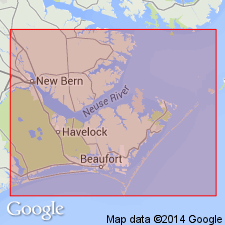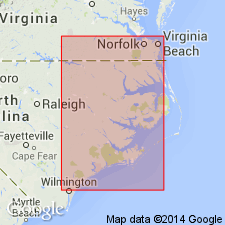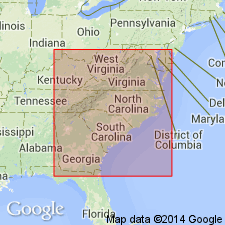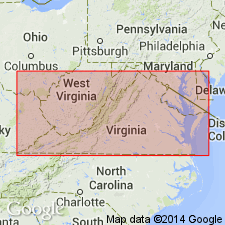
- Usage in publication:
-
- James City Formation
- Modifications:
-
- Named
- Dominant lithology:
-
- Clay
- Sand
- AAPG geologic province:
-
- Atlantic Coast basin
Summary:
Older deposits (Pliocene?) not originally included in Croatan Formation are herein named James City Formation. Composed primarily of unconsolidated calcareous sandy clays and argillaceous sands. Nearly all units contain well-preserved abundant macro microfaunas. Greatest exposed thickness about 8 ft; base not exposed in type area. Lies disconformably below Flanner Beach Formation (new).
Source: GNU records (USGS DDS-6; Reston GNULEX).

- Usage in publication:
-
- James City Formation*
- Modifications:
-
- Overview
- Age modified
- Biostratigraphic dating
- AAPG geologic province:
-
- Atlantic Coast basin
Summary:
Usage of James City Formation follows that of DuBar and Solliday (1963) who named it to replace lower Pleistocene part of sediments not originally included in Croatan Formation. Author concurs with DuBar and Solliday's recommendation to abandon Croatan Formation. Assigned as topmost formation in Chesapeake Group. James City Formation extends from its type area to outcrops downriver along Neuse River 20 km to vicinity of Cherry Point Landing, Craven Co., NC. Extends northward to Aurora, Beaufort Co. Extends southward to near the mouth of the New River in Onslow Co. A unit found 30 m below surface on Core Banks correlates with James City Formation on basis of mollusk content. James City correlates with Waccamaw Formation of southeastern NC and eastern SC. Waccamaw is dated at between 1.8 and 1.6 m.y. on basis of GLOBOROTALIA TRUNCATULINOIDES (d'Orbigny) and GLOBIGERINOIDES OBLIQUS OBLIQUS Bolli from exposure at Walkers Bluff, NC (Akers, 1972). Age of James City is changed from Pliocene(?) to early Pleistocene.
Source: GNU records (USGS DDS-6; Reston GNULEX).
- Usage in publication:
-
- James City Formation
- Modifications:
-
- Revised
- AAPG geologic province:
-
- Atlantic Coast basin
GNU Staff, 1991, GNU Staff remark by E.D. Koozmin. James City Formation.: U.S. Geological Survey Digital Data Series, DDS-6, 1 CD-ROM., release 3
Summary:
Although Blackwelder (1981) assigns James City Formation to top of Chesapeake Group in NC, several reports published since 1981 have discussed units in the Chesapeake Group and do not include the James City Formation (Ward, 1985; Johnson and Berquist, 1989; Mixon and others, 1989; Ward and Powars, 1991). Although most discuss the Chesapeake Group in VA or MD, Ward and Powars (1991) discuss the Chesapeake Group in southern VA and northeastern NC where they show the late Pliocene Chowan River Formation as the top of the Chesapeake Group. According to GNC records, the age of the Chesapeake Group does not extend into the Quaternary; therefore, the James City Formation should probably be excluded from the Chesapeake Group.
Source: GNU records (USGS DDS-6; Reston GNULEX).

- Usage in publication:
-
- James City Formation
- Modifications:
-
- Overview
- Areal extent
- Biostratigraphic dating
- AAPG geologic province:
-
- Atlantic Coast basin
Summary:
Unit is a very shelly sand, which unconformably overlies the Chowan River Formation over much of that unit's extent in the Albemarle embayment. From the Neuse River southward, the James City overlies older rocks of various ages, ranging from the middle Miocene Spring Garden Member of the Castle Hayne Formation to the upper Oligocene River Bend and Belgrade Formation. Deposit originated in open-marine, shallow-shelf environment. Contains a diverse molluscan assemblage dominated by subtropical species. Northern limit of the James City is uncertain. It has not been found north of the Norfolk arch and authors believe it pinches out well to the south of the arch. Southward, unit extends at least as far as the New River. Further south, correlative deposits are assigned to the Waccamaw Formation. The James City actually contains several beds of slightly different ages. They are of similar lithology but contain different molluscan assemblages. All, however, are within the early Pleistocene.
Source: GNU records (USGS DDS-6; Reston GNULEX).

- Usage in publication:
-
- James City Formation
- Modifications:
-
- Age modified
- Overview
- AAPG geologic province:
-
- Atlantic Coast basin
Summary:
James City was initially called Croatan beds by Dall (1892). According to Hazel (1983), the Croatan is an earlier valid usage synonymous with the James City, since MacNeil (1938) designated a type section for the Croatan. However, the James City "has acquired prevailing usage" and is used here. The James City, upper Waccamaw, and upper Caloosahatchee faunas were victims of the same extinction event, which has been dated by Lyons (1991) as pre-1.5 Ma. The younger dates (1.1 and 1.4 Ma from coral) of McCartan and others (1982) are either minimum dates or came from the overlying Bermont. This author assigns the James City to the late Pliocene based on the Krantz (1991) oxygen isotope model, which predicts ages of 1.9 to 2.1 Ma. These youngest beds of the Yorktown depositional basin are known only from NC.
Source: GNU records (USGS DDS-6; Reston GNULEX).

- Usage in publication:
-
- James City Formation*
- Modifications:
-
- Overview
- AAPG geologic province:
-
- Atlantic Coast basin
Summary:
James City Formation is a fossiliferous, medium to coarse quartz sand that varies in thickness from less than 2 m to more than 24 m in the Aurora district. Its greatest thicknesses correspond with sites where erosion has deeply incised underlying formations. Benthic foraminiferal assemblages vary from highly diverse to domination by one or two marginal marine species. Exceptionally rich macrofauna contains a diverse array of mollusks with occasional coral-rich horizons. Unconformably overlies either the Chowan River Formation or the Yorktown Formation, where the Chowan River has been eroded. Unit shown as late Pliocene and early Pleistocene on geologic section at Lee Creek Mine.
Source: GNU records (USGS DDS-6; Reston GNULEX).
For more information, please contact Nancy Stamm, Geologic Names Committee Secretary.
Asterisk (*) indicates published by U.S. Geological Survey authors.
"No current usage" (†) implies that a name has been abandoned or has fallen into disuse. Former usage and, if known, replacement name given in parentheses ( ).
Slash (/) indicates name conflicts with nomenclatural guidelines (CSN, 1933; ACSN, 1961, 1970; NACSN, 1983, 2005, 2021). May be explained within brackets ([ ]).

